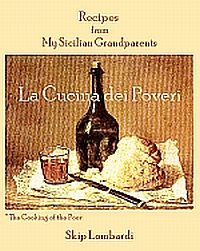Indian Potato Salad
July 3rd, 2011It’s Independence Day weekend 2011 and your fridge is full. It’s 118° F. in Phoenix, in the 90’s in the mid-Atlantic states, and at least that hot in Florida, where thunderstorms will probably trip the breaker on your air-conditioner at least once during the holiday. You’re having people come over for a cook-out or taking food to a picnic, and you’ve already run twice to the bait shop or CVS for extra ice…
Well, here’s one dish that you can make ahead and that you don’t have to chill—Potato Salad.
“Potato salad!? Are you kidding?” you say, remembering decades of horror stories of mayo-dressed salads that sickened entire First Communion parties or sent picnicking beachcombers to the ER.
Yes, potato salad. But one made without mayonnaise.
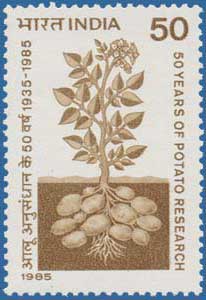
Today’s recipe takes a cue from a democracy as raucous as our own—India, where millions of vegetarians don’t eat eggs, but where cooks have devised myriad ways to elevate spuds to nirvana. Speaking of elevation, during the British Raj, gardeners developed local varieties for their hill-stations, their cooler summer residences. Sixteenth-century Portuguese traders first introduced the potato to India, but local laborers and English colonizers were the ones who struggled through droughts and monsoons to establish the crop in the Subcontinent. The named Indian cultivars of Solanum tuberosum are the stuff of Masterpiece Theatre: Magnum Bonum, Royal Kidney, Great Scot, and (our favorite) Craig’s Defiance. The Brits were homesick for their chips and shepherd’s pies, but what the spice masters of India learned to do with this New World tuber took things to another level. As a vehicle for other flavors, nothing beats the potato.
The potato also gives us an opportunity to champion a once-common American kitchen fixture that Indians continue to use with ease and flair. Though most American cooks don’t think of it as a hot-weather heat-saver, the pressure cooker is a miserly consumer of BTU’s and, thus, easy on the cook as well as the planet. (Of all the freedoms Americans enjoy and celebrate this weekend, for most of us, liberation from the power-grid is not one of them.) Because it cooks foods so much faster than a typical, lidded pot, we use our pressure cooker throughout the hot weather, to cut down on kitchen heat.

In particular, we love ours because it cooks whole potatoes in their skins so quickly and evenly. Just the energy saved in making your summertime potato salads could justify getting one. We promise you’ll find the pressure cooker to be, as one of us likes to say when he is feeling stentorian, “a trusted and valuable member of the culinary armamentarium.” The fact is that today’s pressure cookers are simple, efficient, and safe. (So, now you can relegate any urban legends about exploding pressure-cookers to the trash, right along with those bad mayonnaise memories.)
We offer our fear-free Indian Potato Salad. Whether you make it with—or without—a pressure cooker, do so at least an hour (and up to 12 hours) ahead of serving and remember that the flavors need a little time to meld. The salad is best at room temperature. You can refrigerate any leftovers, but we rarely have any.
Indian Potato Salad
Ingredients:
2 lbs. Waxy potatoes (we like Klondike Rose & Yukon Gold)
2 tsp. Whole mustard seeds (brown or yellow)
1 Tbs. Canola or other neutral oil
1/4 tsp. Salt
1/2 tsp. Hot red pepper flakes (optional)
4 Tbs. Vinegar (we like white wine or cider vinegar)
1/2 Cup Fresh cilantro or spearmint leaves, snipped with scissors
Freshly ground black pepper & salt, to taste.
Fresh lime wedges for garnish
Preparation:
To cook the potatoes:
Boil whole, scrubbed potatoes in their skins. Cook them until there is slight resistance when you try to pierce one to the center with the point of a sharp knife. Turn off the burner and leave them, covered in the hot water, until you are ready to use them. They will continue to cook.
If you are using a pressure cooker, follow the product directions for whole potatoes, or save even more energy and do it our way:
Fill the cooker half-way with water and unpeeled potatoes. Seal the cooker and bring it up to pressure on high heat. When it begins to hiss, reduce heat to medium and let the potatoes cook for 5 minutes. Turn the burner off and let the cooker sit, undisturbed, for at least 30 minutes. (Longer is OK. The residual heat will not overcook the potatoes.) This formula will cook two or three pounds of potatoes (even if they are mixed sizes) to perfection.
When you are ready to make the salad, release any remaining pressure from the pot and open the pressure cooker.
No matter how you have boiled your potatoes, the directions are now the same:
Drain the potatoes and put them cut them into large (1 1/2-inch / 4 cm) chunks, leaving the skins on the pieces. Put the pieces in a large mixing bowl and set aside.
Place the mustard seeds, oil, and 1/4 tsp. salt in a very small sauce pan with a lid. (Because you will have it on very high heat, do not use a pan with a synthetic non-stick coating, like Teflon. However, anodized aluminum is okay.)
Stir the seeds to coat them with the oil and cover the pan. Heat a small burner to high. With the lid securely on, place the pan on the hot burner and reduce the heat to medium. You will soon begin to hear the mustard seeds pop in the hot oil. When the popping stops (in about one minute or less), turn off the burner. Keeping the lid on, remove the pan from the heat and set aside to cool slightly for 1 minute. Keep it covered as a few more seeds may pop.
After a minute has passed, and if you are using the hot pepper flakes, stir them into the hot oil and seeds.
Have the vinegar at hand.
With a spoon, scrape all the toasted seeds and oil from the pan into the potatoes. Carefully pour the vinegar into the sauce pan to rinse out any remaining seeds and oil and then pour that over the potatoes. With a large spatula or wooden spoon, gently stir the potatoes until the seeds are evenly distributed.
If the potatoes are still hot, wait 10 minutes until they have cooled slightly and then add the snipped cilantro or mint and freshly ground black pepper. Stir to distribute evenly. Taste for salt. You may add a little more vinegar, to taste; the potatoes will absorb it.
Serves 4 – 6, depending on your other side dishes
Feel free to vary the fresh herbs. For Indians, neither basil nor tarragon is a salad herb, but either is lovely with mustard seeds. To amplify the Indian aspect, we like to add freshly grated ginger and the rind of a grated lime. If you need more fireworks, judiciously add a few chopped chilies (fresh, pickled, or dried).
As our founding fathers demonstrated, the Fourth of July is an auspicious date for grand experiments!
Turkish Loquat Kebab
April 11th, 2010If you live anywhere in Florida, as far to the north as US Dept of Agriculture Zone 7, you can see Eriobtrya japonica, loquat trees, beautiful broad-leafed evergreens native to Japan and China. If you are in the Carolinas, your loquats may be purely decorative shade specimens that rarely bear fruit. But here in Florida, we are especially lucky this year; even after some serious freezes, the 2010 loquat “crop,” at its peak right now, is the best we’ve seen in years. The small, oval fruits range from pale green to the color of apricots, when they are ripe.
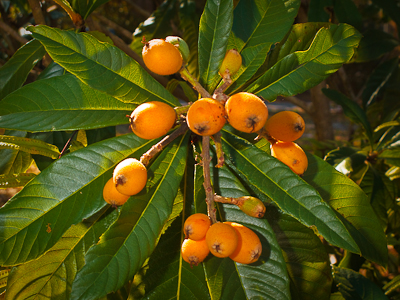
Copyright © 2010, Skip Lombardi
To the unfamiliar, ripe loquats look a lot like queen palm fruits, which are falling to the ground now. But once you see loquats against their tree’s distinctively veined and fuzzy leaves, there’s not chance of confusion. Palm trees look nothing like loquats!
People in my part of the world, the Mediterranean and the Middle East, love loquats, which are often misidentified by tourists as medlars, a different, northern fruit that is rarely cultivated in North America. Nonetheless, medlars and loquats are both members of Rosaceae, the Rose family—along with all the stone-fruits, quinces, apples, and pears. (Known as nespre and nespoli in France and Italy, the Turkish names for loquats translate as “Malta plums” or simply “New World,” odd tags for fruit from the Far East.)
Turks cannot enjoy loquats quite so early as Floridians. They come into the Istanbul and Ankara markets in May, along with strawberries. Restaurants will offer diners platters of fresh strawberries and loquats, and one could certainly do that here in Florida this year. Although mature loquats shade yards and streets throughout older Florida neighborhoods, very few residents seem to realize that loquats are edible. We continue to be amazed that so many delicacies go unharvested here. Perhaps we should call this post Florida Foraging 202…
Human ignorance is the birds’ and squirrels’ gain. Many a fruit will have a tiny peck from a jay or mocking-bird. (That’s one way to be sure they’re ripe! They are still safe to eat.) And if the fruit have already fallen to the ground and are a bit bruised, but intact, don’t discard them. Fruit soft enough to bruise will be sweet.) Just rinse them off and pit them; most have one or two shiny brown seeds that you can quickly and easily remove with your fingers. Enjoy loquats fresh, in salads, or—as the Turks do—briefly cooked in meat dishes.
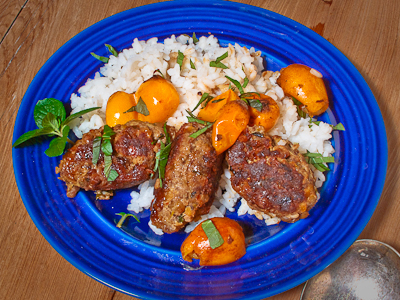
Copyright © 2010, Skip Lombardi
This is hardly nouvelle cuisine. The combination of fruit with meat has roots in the pre-Islamic cooking of ancient Iran. When Islam came to Iran in the seventh century AD, it quickly appropriated the sophisticated cuisine of the Persian elite, who had long cultivated fruits indigenous to Mesopotamia and more distant regions of Asia. The spread of Islam and its willingness to incorporate non-Arab customs meant that, within a few centuries, Persian cooking styles were known from Central Asia and Northern India to the entire Mediterranean and beyond–as far as the Atlantic shores of Portugal and Morocco. Today, many of Morocco’s complex dishes of meat slowly cooked with tart fruit (whose acidity acts to tenderize the meat) are strikingly similar to creations that would have been served in ancient Persia.
The juncture of agricultural richness and continued cultural interchanges between northern Syria and southeastern Turkey have helped maintain many unique regional dishes that still whisper the influence of Persia.
In the Turkish province of Gaziantep along the Syrian border, loquats and lamb come together in an easily made dish with flavors as complex and beguiling as the region itself. Here is one version of the regional treat known as Yeni Dünya Kebabi.
Turkish Loquat Kebab (YENI DÜNYA KEBABI)
Such entertaining confusion just seems to be an everyday seasoning in this part of the world, as highlighted by the old song, It’s Istanbul, not Constantinople.
Ingredients:
6 ounces brown or green lentils
8 ounces ground lamb (leg or shoulder meat)
1 medium yellow onion
2 cloves of garlic
2 tsp minced fresh ginger
Italian flat-leaf parsley (enough to yield at least 1/2 cup when minced)
1 tsp freshly ground black pepper
1 tsp freshly ground allspice
1 tsp cinnamon
2 tsp dried oregano
2 tsp sweet paprika
1-2 tsp red chili flakes, to taste*
1 Egg, beaten
1/3 to 1/2 cup fine, dry bread breadcrumbs (commercial are OK)
Salt to taste
At least 20 loquats, as many as 40
1 Tablespoon pomegranate concentrate (nar pekmez in Turkish)
or ordinary balsamic vinegar
Fresh spearmint– chopped & sprigs for garnish
*(or Turkish Antep, Urfa or (Syrian) Aleppo pepper– any sweet-hot pepper you like)
Preparation:
Inspect the lentils, removing any debris. Rinse and bring them to a rapid boil in 1 1/2 cups of water in a small saucepan. Turn off the heat and cover the pan. Set it aside.
Pit the loquats and break or cut each into 2-3 pieces. Refrigerate.
Organize all the other ingredients.
In a food processor, mince the ginger, garlic, and onion. Scrape them all into a 2-quart mixing bowl.
Mince the parsley (stems and all) and add to the bowl, along with the ground lamb, egg, and all the seasonings. With a spoon or spatula stir them to combine.
Check the lentils; they will have absorbed most of the water and should be almost done, with some resistance when you bite one. Drain them, reserving any liquid.
Pulse lentils in the food processor a few times, to break them up.
Stir the lentils into the meat mixture. Add the bread crumbs, more or less, depending on how wet or dry the mixture seems to be. You want to be able to form 16-20 oval meat patties (köfte, in Turkish), each about 2 inches long. Köfte may be made up to 24 hours before finishing the dish.
In a large non-stick skillet, 12-14 inches, sauté the köfte over medium heat. Allow them to brown for 5-7 minutes on one side before turning them (this parcooks them and makes them easier to turn. Turn the köfte, and as you are browning them, add the reserved loquats to the pan. If anything begins to stick, add any of the reserved lentil broth or a little water. When the meat is browned and the loquats have started to soften, drizzle the pomegranate concentrate or balsamic vinegar over the köfte.
Serve the köfte and any pan juices with white rice or bulgur pilav. Sprinkle each portion with freshly snipped mint and garnish with a sprig of mint.
For details on loquat cultivation see the excellent botanical website: http://www.floridata.com/ref/e/eriobot.cfm
Salads of Morocco 101
March 13th, 2009Of all the combinations of flavor and texture that one may experience around the Mediterranean rim, the salads of Morocco are among the brightest surprises. There are scores these side dishes, which vary by region and season—indeed, from house to house. Moroccan salads may include any or all of these: sugar, distilled orange-blossom water, cinnamon, cumin, caraway, saffron, cilantro, parsley, mint, red onions, chillies, or a few drops of argan oil (expressed from pits of the fruit of Argania spinosa, a desert tree indigenous to Morocco.)
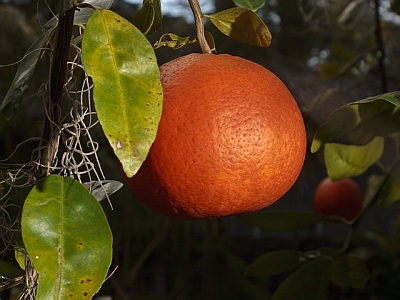
Backyard Mineola Orange
Copyright © 2009, Skip Lombardi
Beets and oranges are a favorite pairing; depending on a cook’s whim, the two might also be combined with other vegetables (carrots, cucumbers, peppers, or turnips).
Interesting and delicious as these North African permutations are, we think Florida’s late winter citrus and local beets are best appreciated with just a few adornments. (Whoever said that flavorful greens and root-crops can’t be grown in the sandy soils of the Sunshine State has not sought out the beets of Florida’s farmer’s markets. Our source says that his are harvested in the area around Lake Okeechobee.)
Dressed simply with olive oil and lemon juice, this gorgeous salad is easy to prepare and complements grilled fish, poultry, or meat equally well. Try to use an orange cultivar that has few seeds and is easy to peel. For maximum color contrast, crimson beets are our choice. (Be sure to save the greens and stems to stir-fry or add to soups).
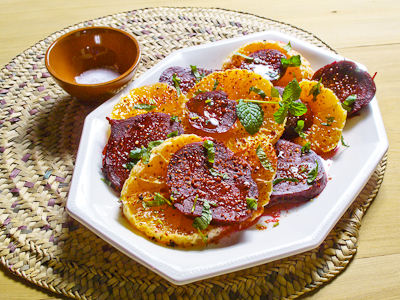
Copyright © 2009, Skip Lombardi
The spirit of Morocco and the taste of our our local produce both come through in this dish.
Beet and Orange Salad
Ingredients:
1 lb Crimson beets (Skins left on; tops removed & saved for another use)
1 lb Sweet oranges (Mineola, Honeybell, Temple, and tangelo work well)
Juice of 1/2 lemon or lime
2 Tbsp Olive oil
Black pepper, freshly and coarsely ground
1/2 Tbsp Sweet-hot paprika, or to taste (see note)
1/2 tsp coarse salt
2-3 Tbsp snipped spearmint leaves, plus a sprig for garnish
Preparation:
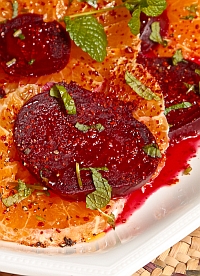
Copyright © 2009, Skip Lombardi
Cook the beets, in their skins, until you can pierce one with a sharp knife blade. (We like a little resistance at the center.) Allow to cool and slip off the skins. Slice in rounds, 1/4 inch thick, and set aside.
Peel the oranges carefully, trying not to separate the segments. Remove as much of the membrane as you can. On a large plate (to catch the juice), cut the oranges across the segments into slices 1/2 — 1/4 inch thick. (Some slice more easily than others; save any “broken” segments.) Pick out any seeds. Reserve the juice to pour over the salad later.
On a clean platter, place any less-than-perfect pieces of orange and cover them with overlapping slices of beets and orange. Pour the excess orange juice over the beets.
20 minutes before serving, squeeze the juice of the lemon (or lime) over all. Drizzle on the oil and then sprinkle with salt, black peper, and the paprika (see note). Finely snip the mint over the entire platter. Garnish with a full sprig of mint.
Serves 2 — 4
Sihhateyin! Bon appetit!
Pasta with Caviar
February 12th, 2009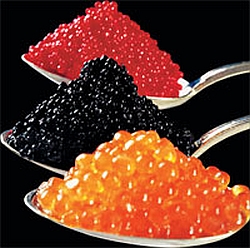
Whether or not you have already enjoyed Pasta ai Caviale along on the Italian Riviera, you’ll find that the dish will bring a little warmth to a mid-winter evening anywhere. Though light enough for a late-night summer supper, at this time of year it’s a favorite pasta course in a more substantial meal. Ligurians typically use black lumpfish caviar.
For Valentine’s Day, we find the reddish-pink of salmon roe to be a more festive, and equally affordable, touch. The translucent orange beads of trout roe and Japanese tobiko (flying fish roe) are comparably priced. They, too, impart a bright, briny flavor and pleasant crunch.
A well-chilled Verdicchio, Prosecco, or Portuguese vinho verde would complement the dish and still leave you enough cash for fresh flowers.
Happy Valentine’s Day!
Pasta ai Caviale
Ingredients:
3 Tbs. Unsalted butter
2 Scallions, including green tops, finely chopped
3 or 4 Grinds of the pepper mill
1/2 Cup mascarpone or sour cream
4 Tbs. Flat-leaf Italian parsley, finely chopped
4 oz. Salmon or other red “caviar”
1 Lb.Fettucine or linguine
Garnish:
1 Lemon, quartered
4 sprigs of parsley
Preparation:
Bring a large pot of salted water to the boil.
Heat a large sauté pan over medium heat, then add the butter. When the butter has foamed and the foam begins to subside, add the scallions and a few grinds of pepper. Sauté until the scallions are wilted, about one minute. Add the mascarpone or sour cream and reduce heat. Simmer for a minute or two.
When the water comes to the boil, add the pasta.
As the pasta cooks, simmer the sauce for another minute, then remove from the heat. Stir in the parsley and set the sauce aside until the pasta finishes cooking.
When the pasta has reached the al dente state, drain in a colander, reserving approximately one cup of the cooking water. Add the drained pasta to the sauce and toss gently to combine. If the sauce seems too thick, add some of the cooking water, 1/4 cup at a time.
To serve:
Divide pasta and sauce equally among four plates. Let the pasta cool for one minute on the plates before garnishing with the caviar. (If the pasta is too hot, it will “cook” the roe).
Top each portion with a tablespoon or two of the caviar.
Garnish each plate with a lemon wedge and a parsley sprig. Let each diner squeeze on his own lemon juice, to taste.
Serves four.


